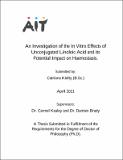| dc.contributor.advisor | Kealey, Carmel | |
| dc.contributor.advisor | Brady, Damien | |
| dc.contributor.author | Kielty, Catriona | |
| dc.date.accessioned | 2022-07-06T15:48:54Z | |
| dc.date.available | 2022-07-06T15:48:54Z | |
| dc.date.copyright | 2021 | |
| dc.date.issued | 2021-04 | |
| dc.identifier.citation | Kielty, C. (2021). An investigation of the in vitro effects of unconjugated linoleic acid and its potential impact on haemostasis. Thesis (Doctor of Philosophy - PhD). Athlone Institute of Technology. | en_US |
| dc.identifier.uri | http://research.thea.ie/handle/20.500.12065/4020 | |
| dc.description.abstract | Introduction: Linoleic acid, an essential ω6 fatty acid, is the most abundant
polyunsaturated fatty acid in the Western mammalian diet. Linoleic acid has been linked
with an increased inflammatory response. It has also been associated with platelet
inhibition and with a reduction in platelet thromboxane. Excessive unresolved
inflammation can lead to uncontrolled tissue damage and has been associated with several
inflammatory mediated diseases. Plasma free fatty acids are known to increase in several
disease states as well as during fasting and strenuous exercise. As such, this investigation
aimed to elucidate the potential mechanisms by which linoleic acid at supraphysiological
concentrations may impact cell health in the liver and the vasculature.
Methods: In vitro investigations were used to determine the effects of increasing
concentrations of ULA on the inflammatory response. Assays were performed using the
human hepatoma cell line, HepG2 and the human umbilical vein endothelial cell line
HUVEC. The effects of supraphysiological concentrations of ULA over 8 hours of
exposure were assessed. Both cell lines were assayed for the effects of ULA on cell
viability and intracellular lipid accumulation. ELISA was used to determine the effects of
ULA on thromboxane A2 and TNF-α production. Cell lysates were assayed for the
presence of superoxide dismutase (SOD). HepG2 cells were also analysed for ULA
induced apoptosis and necrosis using flowcytometry.
Results: Treatment concentrations of 1mM and 2.5mM of ULA induced a significant
reduction in cell viability even after 1 hour of treatment in both cell lines. The ability of
both cell lines to sequester ULA intracellularly at these concentrations was also
significantly reduced compared to cells treated with the more physiologically comparable
0.1mM. HepG2 cells treated with 1mM and 2.5mM of ULA presented with a significant
reduction in the presence of SOD after 4 hours. However, ULA had no significant effect
on the presence of SOD in HUVEC cells. HepG2 cells also presented with increased
apoptosis and necrosis at these concentrations after 4 hours of treatment. HUVEC cells
treated with 1mM and 2.5mM of ULA showed a significant increase in thromboxane A2
secretion. However, no significant effect on thromboxane A2 production was observed in
HepG2 cells.
Conclusion: The data suggests that ULA, at supraphysiological concentrations induces
cell dysfunction in a number of ways depending on cell type. While Linoleic acid may
not directly induce specific disease states, in a system compromised by disease or
physiological stress, increasing plasma concentrations of linoleic acid, leading to
increasing ROS and diminished antioxidant capabilities may initiate or further exacerbate
pathophysiology. | en_US |
| dc.format | PDF | en_US |
| dc.language.iso | eng | en_US |
| dc.publisher | Athlone Institute of Technology | en_US |
| dc.rights | Attribution-Non-Commercial-Share-Alike-4.0 International | * |
| dc.rights.uri | http://creativecommons.org/licenses/by-nc-sa/4.0/ | * |
| dc.subject | Unconjugated linoleic acid | en_US |
| dc.subject | Haemostasis | en_US |
| dc.title | An investigation of the in vitro effects of unconjugated linoleic acid and its potential impact on haemostasis | en_US |
| dc.type | info:eu-repo/semantics/doctoralThesis | en_US |
| dc.contributor.affiliation | Athlone Institute of Technology | en_US |
| dc.identifier.orcid | https://orcid.org/ 0000-0002-5203-0995 | en_US |
| dc.rights.accessrights | info:eu-repo/semantics/openAccess | en_US |


